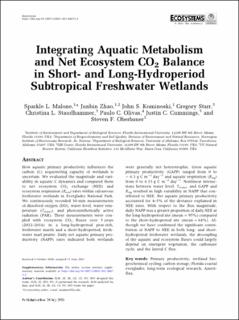Integrating aquatic metabolism and net ecosystem CO2 balance in short- and long-hydroperiod subtropical freshwater wetlands
| dc.contributor.author | Malone, Sparkle L. | |
| dc.contributor.author | Zhao, Junbin | |
| dc.contributor.author | Kominoski, John S. | |
| dc.contributor.author | Starr, Gregory | |
| dc.contributor.author | Staudhammer, Christina L. | |
| dc.contributor.author | Olivas, Paulo C. | |
| dc.contributor.author | Cummings, Justin C. | |
| dc.contributor.author | Oberbauer, Steven F. | |
| dc.date.accessioned | 2021-10-18T10:24:59Z | |
| dc.date.available | 2021-10-18T10:24:59Z | |
| dc.date.created | 2021-08-25T13:32:09Z | |
| dc.date.issued | 2021-07-29 | |
| dc.identifier.citation | Ecosystems. 2021, . | en_US |
| dc.identifier.issn | 1432-9840 | |
| dc.identifier.uri | https://hdl.handle.net/11250/2823641 | |
| dc.description.abstract | How aquatic primary productivity influences the carbon (C) sequestering capacity of wetlands is uncertain. We evaluated the magnitude and variability in aquatic C dynamics and compared them to net ecosystem CO2 exchange (NEE) and ecosystem respiration (Reco) rates within calcareous freshwater wetlands in Everglades National Park. We continuously recorded 30-min measurements of dissolved oxygen (DO), water level, water temperature (Twater), and photosynthetically active radiation (PAR). These measurements were coupled with ecosystem CO2 fluxes over 5 years (2012–2016) in a long-hydroperiod peat-rich, freshwater marsh and a short-hydroperiod, freshwater marl prairie. Daily net aquatic primary productivity (NAPP) rates indicated both wetlands were generally net heterotrophic. Gross aquatic primary productivity (GAPP) ranged from 0 to − 6.3 g C m−2 day−1 and aquatic respiration (RAq) from 0 to 6.13 g C m−2 day−1. Nonlinear interactions between water level, Twater, and GAPP and RAq resulted in high variability in NAPP that contributed to NEE. Net aquatic primary productivity accounted for 4–5% of the deviance explained in NEE rates. With respect to the flux magnitude, daily NAPP was a greater proportion of daily NEE at the long-hydroperiod site (mean = 95%) compared to the short-hydroperiod site (mean = 64%). Although we have confirmed the significant contribution of NAPP to NEE in both long- and short-hydroperiod freshwater wetlands, the decoupling of the aquatic and ecosystem fluxes could largely depend on emergent vegetation, the carbonate cycle, and the lateral C flux. | en_US |
| dc.language.iso | eng | en_US |
| dc.publisher | Springer Nature | en_US |
| dc.rights | Navngivelse 4.0 Internasjonal | * |
| dc.rights.uri | http://creativecommons.org/licenses/by/4.0/deed.no | * |
| dc.title | Integrating aquatic metabolism and net ecosystem CO2 balance in short- and long-hydroperiod subtropical freshwater wetlands | en_US |
| dc.type | Peer reviewed | en_US |
| dc.type | Journal article | en_US |
| dc.description.version | publishedVersion | en_US |
| dc.rights.holder | © 2021 The Author(s) | en_US |
| dc.source.pagenumber | 19 | en_US |
| dc.source.journal | Ecosystems | en_US |
| dc.identifier.doi | 10.1007/s10021-021-00672-2 | |
| dc.identifier.cristin | 1928694 | |
| cristin.ispublished | true | |
| cristin.fulltext | original | |
| cristin.qualitycode | 2 |
Files in this item
This item appears in the following Collection(s)
-
Divisjon for miljø og naturressurser [761]
Publikasjoner knyttet til ansatte ved Divisjon for miljø og naturressurser -
Publikasjoner fra CRIStin - NIBIO [4593]
-
Vitenskapelige artikler [1416]

